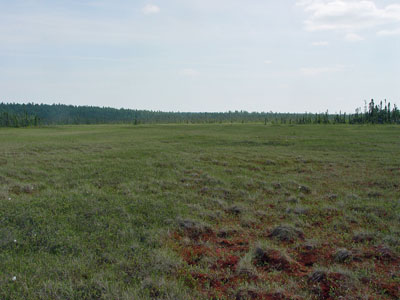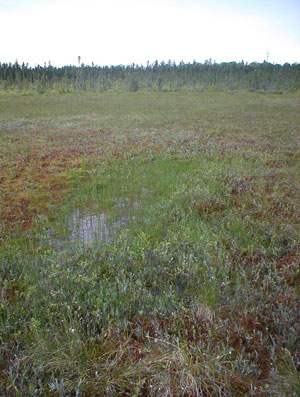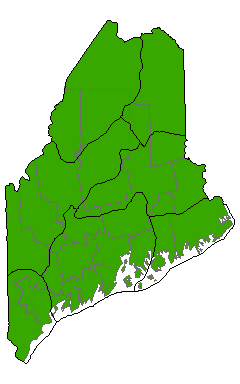DACF Home → Bureaus & Programs → Maine Natural Areas Program → Communities, Plants, and Animals → Natural Community Fact Sheets → Sedge - Heath Fen
Printer Friendly Fact Sheet - 820 KB pdf (Get a free copy of Adobe Acrobat Reader)
Sedge - Heath Fen
Scientific Name: Sedge - Leatherleaf Fen Lawn; State Rank: S4

- Community Description
- Soil and Site Characteristics
- Diagnostics
- Similar Types
- Conservation, Wildlife and Management Considerations
- Distribution
- Characteristic Plants
- Associated Rare Plants
- Associated Rare Animals
- Examples on Conservation Lands You Can Visit
Community Description: This open peatland vegetation is dominated by a layer of mixed dwarf heath shrubs and sedges. Small larches, rarely tree sized, are often scattered across the surface but contribute little cover. Leatherleaf, sweetgale, or bog rosemary may be the dominant shrub, and shrub cover is generally 20-40%. Sedges contribute 20-70% cover. Narrow-leaved cotton-grass, few-seeded sedge, and Michaux’s sedge are typical dominants. Pitcher plants are usually present. The ground layer is a carpet of peat mosses, often with tracings of large cranberry running across the surface. Back to top.

Soil and Site Characteristics: This type occurs in open peatlands, often in areas transitional from raised bog (ombrotrophic) to fen (minerotrophic) conditions. Sites are typically acidic (pH 4.0-5.4) but sometimes circumneutral. Peat substrate is saturated to the surface, or nearly so. This type most often occurs at low to moderate elevations. Back to top.
Diagnostics: Open peatland vegetation consists of sedges and dwarf shrubs (leatherleaf, bog rosemary, sweetgale). Sedge cover exceeds shrub cover. Dominant sedges include few-seeded sedge, coast sedge, Michaux’s sedge, white beakrush, and narrow-leaved cotton-grass. Back to top.
Similar Types: Leatherleaf Bogs are shrubbier, have more leatherleaf than sedge cover, and have tufted cotton-grass or tawny cotton-grass as prominent sedges. Sheep Laurel Dwarf Shrub Bogs are drier and shrubbier and features sheep laurel as the dominant shrub. A Low Sedge Fen occurs in similar, although usually somewhat wetter settings. It has a greater dominance of sedges than shrubs and often features mud sedge and podgrass. Tall Sedge Fens can consist of leatherleaf among sedges, but the sedges will be large and robust species such as slender sedge, beaked sedge, and inflated sedge. Back to top.
Conservation, Wildlife and Management Considerations: This community type is well represented in Maine and is fairly stable in extent, with several examples on public lands and private conservation lands. Impoundment or draining would have negative impacts on bog hydrology and on vegetation. Slow vegetation growth rates, due to the nutrient poor setting, result in slow recovery from physical disturbances, such as recreational trail use. If disturbance, such as trail crossing, is a priority, traversing during frozen conditions or using boardwalks can minimize impacts.
Several rare dragonflies may be found in this community, especially in very wet locations with abundant peat moss (often suspended in the water column). The Quebec emerald is found in northern Maine, and the ringed boghaunter is restricted to the southern part of the state in York and southern Oxford Counties. In northwestern Maine this type may support the bog fritillary butterfly, which uses small cranberry as its larval host plant. Back to top.
Distribution: Statewide, though more common northward. Throughout northern New England and New York; Canadian distribution unknown. Landscape Pattern: Small Patch. Back to top.


Characteristic Plants: These plants are frequently found in this community type. Those with an asterisk are often diagnostic of this community.
- Sapling/shrub
- Larch*
- Mountain holly*
- Dwarf Shrub
- Bog rosemary*
- Large cranberry*
- Leatherleaf*
- Sheep laurel
- Small cranberry
- Herb
- Bog aster*
- Bog goldenrod
- Coast sedge*
- Few-flowered sedge*
- Few-seeded sedge*
- Narrow-leaved cotton-grass*
- Pitcher plant
- Round-leaved sundew
- Slender sedge
- Spatulate-leaved sundew
- White beak-rush*
- Yellowish sedge
- Bryoid
- Sphagnum magellanicu
There are no documented rare plants associated with this natural community.
- Quebec emerald
- Ringed boghaunter
Examples on Conservation Lands You Can Visit
| Example | County |
|---|---|
| Acadia National Park | Hancock Co. |
| Great Heath Public Lands | Washington Co. |
| Great Wass Island Preserve | Washington Co. |
| Number Five Bog Public Lands | Somerset Co. |
| Salmon Brook Lake Bog Public Lands | Aroostook Co. |
| St. John River Preserve | Aroostook/Somerset Co. |